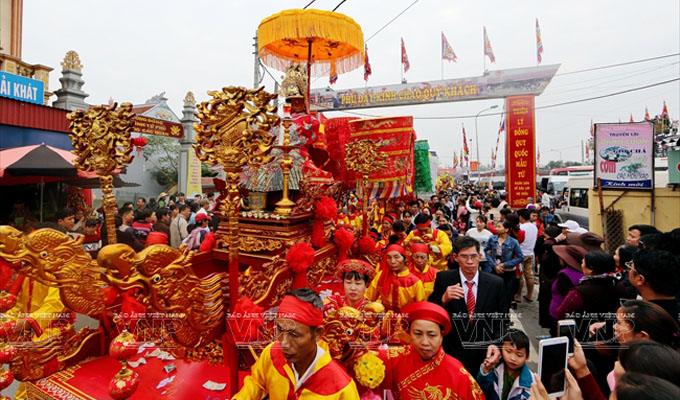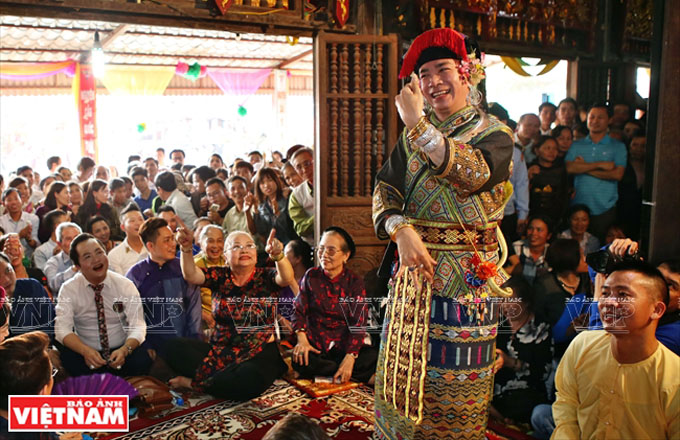A Vietnamese saying goes “Thang Tam gio Cha, thang Ba gio Me” (the Father’s Death Anniversary Falls in the eighth lunar month and the Mother’s in the third lunar month). This shows gratitude respectively to “Duc Thanh Tran” (Saint Tran) and “Thanh Mau Lieu Hanh” (Mother Goddess Lieu Hanh) as the Vietnamese thousands of year-old religious philosophy says “uong nuoc nho nguon” (remember its source when drinking water).

The procession of Mother Goddess Lieu Hanh (Photo:VNP)
The Mother Goddesses religion, considered to be Viet Nam’s oldest religion, is rising in popularity andthe city of Nam Dinh is considered its heart with some 400 Mother Goddesses worship locations. Phu Day is the focal point of this belief.
The Phu Day festival is organised from 3rd – 8th day of the third lunar month, honouring Mother Saint Lieu Hanh, the head deity in the Worship of Mother Goddesses. Mother Goddess Lieu Hanh was worshiped in various localities, but the Phu Day festival is the biggest and most original. The festival lasts many days with diversified activities and “Hat van” or “Hau dong” (chant singing and trancing) is the most prominent. They are rituals with deep colours of esoteric spirits culture, which creates the distinctiveness and strong vitality of this special belief. The Phu Day festival is an important component of a great Lieu Hanh historical chorus. This shows that Phu Day is the centre of the Heritage of Worship of Mother Goddesses.
Phu Day is a complex of traditional religious architecture in Kim Thai Village, Vu Ban District in the northern province of Nam Dinh. Among 21 architectural works of Phu Day complex, three are closely related to Mother Saint Lieu Hanh, including Tien Huong temple (the principal one), Van Cat temple and Lieu Goddess shrine.

Performing the ritual of Hau dong at the festival (Photo: VNP)
During the festival, thousands of people, including locals and tourists travel to Phu Day to pray for happiness, health and prosperity. The six-day festival features numerous traditional rituals, cultural activities and folk games, such as Chau van performances, lion and dragon dances, arts performances at Cay Da Bong temple, a “co nguoi” (human chess) competition and wrestling.
One of the highlights of the festival is a procession of the Mother Goddess’s palanquin and a torchlight procession at Tien Huong temple.
The torchlight procession is held on the night of March 3 with the aim of giving people the belief and hope for a happy and prosperous life. The procession starts with a torch lit at Tien Huong temple and then another 1,000 torches which are processed by the locals around Phu Day. The procession of the Mother Goddess’ palanquin stats from Tien Huong temple to Tien Huong pagoda. During the ritual, three balloon-shaped dragons are released into the sky.
Phu Day Festival with its cultural activities related to Mother Goddesses Worship is an official part of the Intangible Cultural Heritage of Humanity recognised by UNESCO.
|
Tam Phu in the Mother Goddess Worship belief corresponds to three different regions in the universe, namely “Thien phu” (the Heaven region), “Nhac phu” (the forest and mountain region) and “Thoai phu” (the river and water region). Each region is headed by a mother saint, including “Mau Thuong Thien” (the first Mother) managing the firmament and mastering supernatural powers such as clouds and rain, wind and storms, thunder and lightning; “Mau Thuong Ngan” (the second Mother), looking after the forest and mountain region, the main living habitat of various ethnic minorities, and “Mau Thoai” (the third Mother), taking care of the rivers and water region, giving benefits for water rice growing and fishing.
|